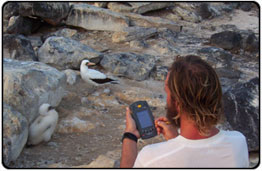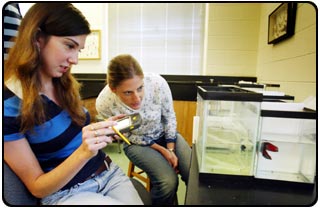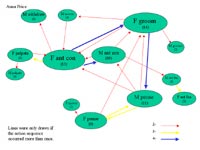Biology research in the palm of a hand – handhelds help track animal behavior

Hand-held computers in use in bird observation on the Galapagos Islands.
In a small, segmented aquarium in Wake Forest University’s Winston Hall, three male betta fish flash their fins and fan their tails to attract a female betta fish. When the female swims in front of a particular male, Wake Forest senior Jonathan Simpson quickly records her choice and measures the previous and subsequent movements of the male on his hand-held computer with a few simple clicks of a stylus. A custom-made software program will track her choices, along with the male’s behavior, and ultimately reveal the common traits that compose the courtship ritual of the betta fish.
Simpson and others in this Wake Forest summer class on animal behavior are using hand-held computers and a software program created specifically for the course that improves the speed and accuracy with which students can log animal movements. It is the newest step in the university’s continued efforts to use technology to enhance the learning process. The university started providing laptops for students in 1996 and has since remained at the forefront of developing academic technology. Classes in other departments, including health and exercise science and foreign languages, have also experimented with hand-held computer use in the classroom.

Lyndsay Zotian ’05, on the left with the handheld computer, and Elizabeth Reynolds ’03, working on an animal behavior experiment with betta fish in a lab room in Winston Hall.
Professor of Biology Bill Conner, who is teaching the summer class on animal behavior, says the hand-held computers and new software program have already proven to be more accurate than pen and paper.
“Behavior in animals happens very rapidly,” Conner says. “This device makes it possible to log some behaviors that otherwise might have been missed.”
Conner teamed with the university’s Information Systems research and development staff and Jeff Muday, a technology consultant in the biology department, to create the program. It allows students to customize their logging program to match the expected behaviors of the animal they are observing.
For example, in an experiment earlier in the summer, students used the program while observing cricket courtship. Tap-buttons on the screen matching common cricket behaviors such as singing or particular movements were pre-programmed into each hand-held computer. Using a lightweight pointer, the students then logged each behavior in a certain time frame by clicking on the appropriate box. The program notes the time and converts the data into a spread sheet that students eventually use to create an ethogram, a graphic representation that characterizes an animal’s behavior.

An ethogram created from data collected using hand-held computers in Conner’s class.
Students are using the technology to observe other animals, as well. David Anderson, associate professor of biology, has used university-provided hand-held technology for several years in his research of birds on the Galapagos Islands. A group of students in Conner’s class used the handhelds this summer to observe puffins at the North Carolina Zoo. The group is currently analyzing the behavior logs of the aquatic birds to determine the difference in male and female puffins’ parental investment in raising their young.
Two of Conner’s biology students also plan to use the program to study bats and moths this fall, and he will use the same program when he teaches animal behavior in the spring.
Conner says that using hand-held computers in animal behavior research holds unlimited possibilities, including the capability of identifying animals that have been tagged with a bar code. By using the hand-held computer to scan the bar code, the particular animal’s behavior history is immediately retrieved, preventing the possibility of recognition error by the researcher.
“This technology is extraordinarily versatile,” Conner says. “We’re just starting to tap into its capabilities.”



